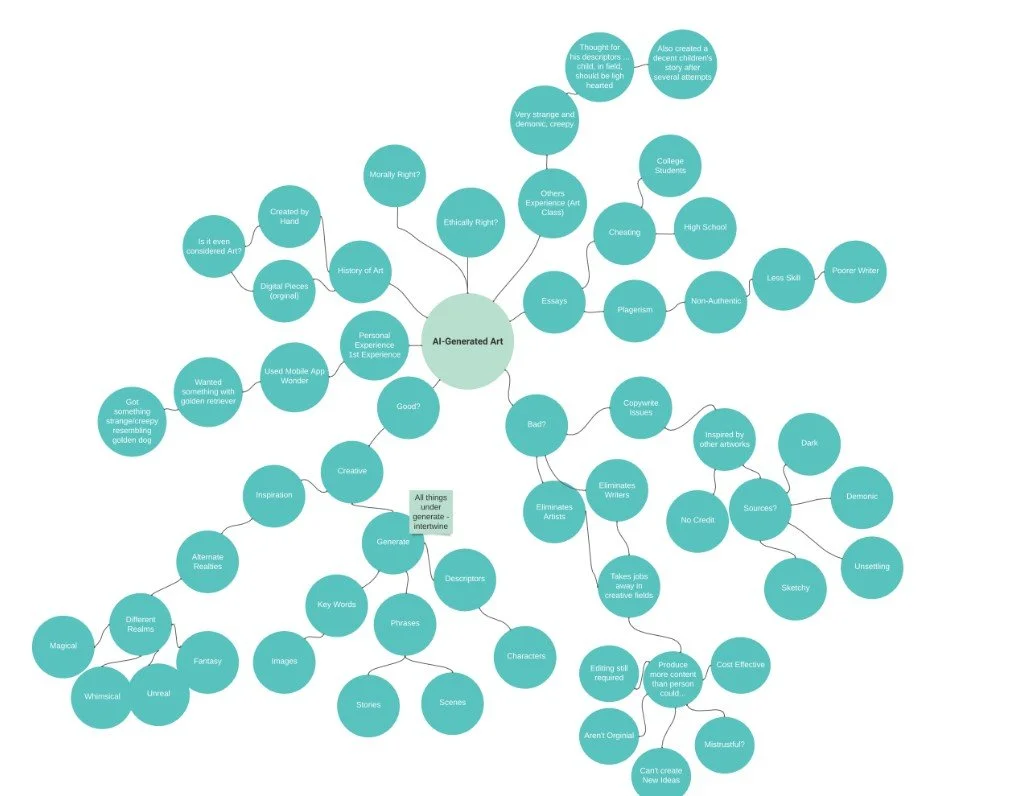
Artificial Intelligence is Revolutionizing Art, for Better or Worse Article.
Published on Medium.com | Click Here to read my full article.
The world of artificial intelligence is on the rise. Think about all the industries it can be seen in today! From self-driving cars to banking and to customer service in call centers and content creation, it is present around us. More recently, the new phenomenon has been AI-generated artwork.
Long-Form Writing Proposal
Click Here to see my full proposal write up.
Clustering Before Writing
Extensive Outlining
Click Here to see my full outline of my AI Article.
Article + Short-Form Writing
The purpose of creating a long form writing proposal is to outline the working title of an article, the nut graf (explains the significance of an article), defines the intended audience, and includes research done that relates to your topic, along with its importance.
Working Title: What is AI-Generated Art and Why it May Not Be Art?
Nut Graf: The topic of AI-Generated Art is something that has been a particular interest of mine in the last few months. We all know that technology is always advancing, and we are closer now than ever to developing all kinds of Artificial Intelligence that can have human capabilities. There are a lot of moral and ethical questions about the content that has been generated and has raised debate on whether it should be considered artwork because it lacks originality and creativity (pulls from existing creations). This is an important topic for me to research and deliver because I am a creative person in general. I am in the advertising field, so it is important to be original and have storytelling skills when creating content.
Audience: Anyone who has in interest in AI or who is in the creative field in general.
Sources: The initial research I found showed both sides of the argument including why artists support AI-generated art and that is essentially another tool like photoshop, backlash from AI winning a contest, and the breakdown the AI-generated art.
The first step in any writing process that is beneficial is creating a mind map or cluster (can be seen on the left). This can be very helpful to identify the potential subtopics of what you want to research more and base your article around. I put AI-generated art at my center than branched off with key words or potential topics and directions I could go. For me, I was really interest on gaining artist’s perspectives and whether they felt AI-generated art was a good or bad thing in the creative world.
Once I finished brainstorming and got all my ideas gathered together, I moved onto extensive research and outlining.
I scoured databases for peer reviewed articles and journals and also took to the internet in search for news articles on AI-Generated Art. I also aimed to find how real artist’s thought and felt about this new technology impacting their field. I spent a lot of time gathering my research on each subtopic and tried seeing AI-Generated Art from both sides. The shorten version of my outline is as followed:
Overview of art in the digital world (photography, photoshop)
The background of AI-Generated art and it’s into how to use it
The process (diving into its science)
Laying out both sides of the argument
What is the good?
What is the bad?
Key Takeaways
Putting a lot of detail into this outline and laying out each subtopic with relevant research made the revision and writing process a lot smoother. I was easily able to section out and write my paragraphs one by one and kept confidence knowing where the article would go majority of the time.
Once my draft was peered reviewed and published on medium.com, I created three sample social media posts in hopes people would be drawn into reading my article (2 of which can be seen to the left).
To see my full blog post on my social media posts, explanations, and captions, Click Here.
My key takeaway from this study was that spending time and putting work into making your outline as detailed as possible will only help benefit in the long run.



